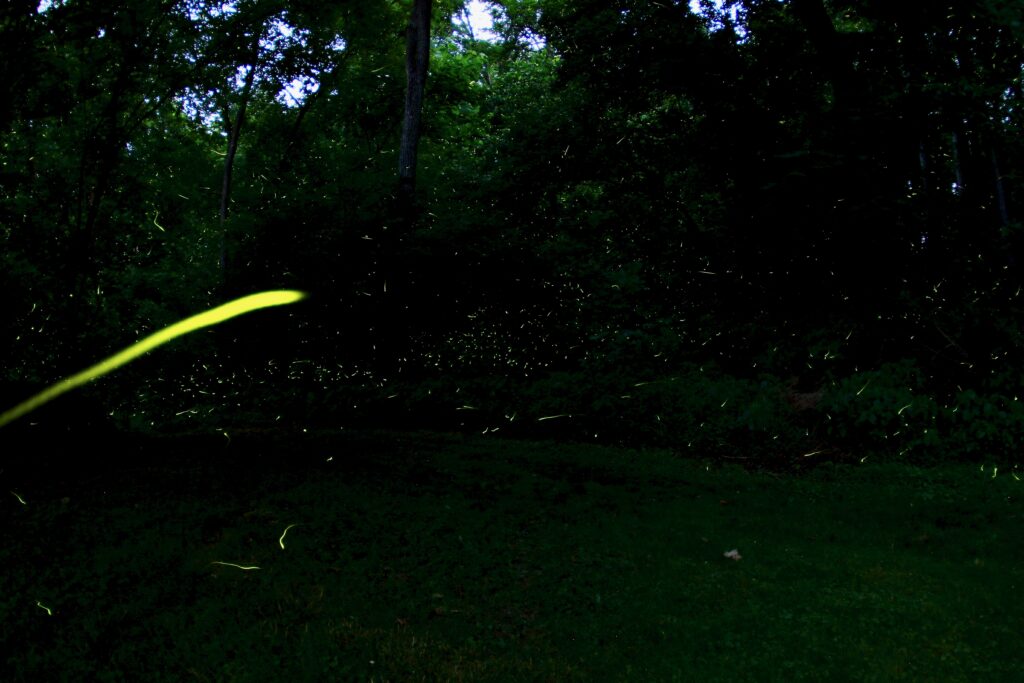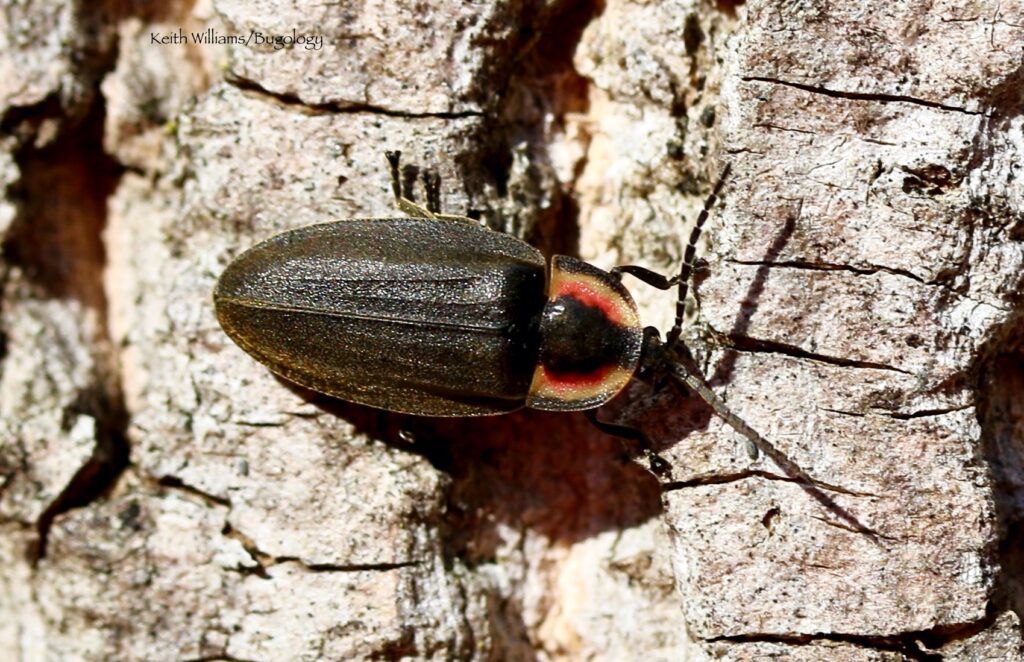By Keith Williams, Vice President of Engagement & Education
Sunlight drifted to the other side of the planet to cast this side in shadow dark enough that the colors of the forest faded to shades of grey. Little lights flickered close to the ground, pale lemon yellow and fast, lasting for less than a moment with just a second or two between flickers. They appeared random at first, but then a pattern became apparent: these little lights skimmed just barely above the ground between the white avens and stilt grass.
The forest under the canopy darkened further, which made the sky that shone through the leafed-out tree branches look bright. More lights appeared, bright longer-lasting flashes that initially drooped then rose up toward the canopy to form the letter J streaked in light.
A little while later a bright second-long flash followed by four seconds of quiet joined the pale yellow fast flashes and rising J’s. Then greenish lights that flew horizontally through the forest started to zip by, and new bright yellow ones appeared that started weak, crescendoed into a light burst, and slowly faded over three seconds.
An hour after dusk, I was bathed in a cacophony of light, different combinations of flash color, duration, intensity, and flight pattern from low to the ground to high in the canopy, from fast and intermittent to long and streaked. The fireflies were out in force. I soaked it in and ignored the urge to identify the six or seven different species that flashed around me. Instead, I focused on staying in the moment, absorbing it all and burning it to memory in case one day I have to tell stories of nights the woods used to light up. Many species of firefly are declining in number, so I paid attention to this moment, just in case.

Fireflies at Climbers Run Nature Center (Photo by Keith Williams)
There are 2,000 species of firefly on the planet, 170 in North America. The Xerces Society evaluated the populations of 132 species and found 12% threatened with extinction. Fifty percent didn’t have adequate data to make a determination about their population status. Once data deficiencies are addressed (if they are), we expect to discover that one-third of the firefly species in North America are threatened with extinction.
Fireflies are beetles in spite of their “fly” name. The first proto firefly appeared 150 million years ago as far as we can tell from the fossil record. Fireflies appeared as we know them today 20 million years ago. And they have used bioluminescence to find mates ever since.
How Fireflies Light Up
Bioluminescence is fairly common in nature. Everything from mushrooms to plankton use it for communication, but few organisms control the light. Fireflies are some of the organisms that do. Males flash a pattern unique to their species using a complex biochemical reaction. Females flash back in response if interested in mating with a particular male.
The lantern organ on firefly abdomens is composed of special cells called photocytes, which contain the chemical platform luciferin. Luciferin has an action site where the enzyme luciferase, adenosine triphosphate (ATP – a molecule that fuels cells), and oxygen can come together. When that happens, luciferin sheds photons of light, and chemical energy is converted to light energy. But the trick is to free up oxygen for this reaction when it is normally consumed by the cells’ mitochondria in the process of cellular respiration (which is how cells produce energy).
Nerve impulses from a firefly’s brain travel to cells in the lantern that release octopamine. Octopamine stimulates cells to make nitric oxide. Nitric oxide temporarily shuts down mitochondrial respiration, which allows the oxygen normally used up by mitochondria to diffuse into the photocytes where it combines with luciferase, ATP, and luciferin to produce light.
Not all fireflies flash, however. There are three broad categories of fireflies: those who emit quick bright lights, those who use slow glows, and a third group who use chemical fragrance via pheromones rather than light to attract the opposite sex. These dark fireflies often do their chemical calling during the day.
Firefly Defense
Fireflies contain toxic steroids called lucibufagins, which are a kind of bufadienolide (named for the Bufo, a genus of toads who secrete these compounds from their parietal glands). They taste horrible and, in high enough doses, disable an enzyme responsible for the sodium-potassium pump which sets up electrical charges on muscle cell walls, including cardiac muscle. Heart muscle without an electrical charge doesn’t contract, meaning the heart doesn’t beat. We think fireflies’ lights evolved as a way of announcing their toxicity to predators.
Firefly larvae have lights even though they aren’t trying to attract a mate – an advertisement to predators that they are toxic, smell bad, and taste horrible. They use lights instead of colors (unlike, for example, a monarch butterfly, which is toxic because of cardeneloides concentrated when it was a caterpillar feeding on its host plant, milkweed). Since firefly larvae live underground and/or are nocturnal, bright warning colors wouldn’t show up or be recognized by predators. We think the act of flashing for a mate evolved from this toxic advertisement.
The Life Cycle of Fireflies
Firefly larvae are voracious predators that eat worms, snails, and other insects. They look the part, too, resembling fierce armor-plated mini dragons. Most firefly species spend their first year as underground larvae. In their second year, they pupate into adults that are looking to mate. Most adult fireflies stop feeding. Nocturnal flights are energetically expensive, and they are all fueled by whatever the insect was able to consume as a larva.

Firefly (Photo by Keith Williams)
Males emerge earlier in the season before females. One study found an early sex ratio of 218 males to 12 females. Of 199 males followed, only two found mates. By the end of summer, though, the male-heavy sex ratio flips and females outnumber males. At this point, females can’t be choosy anymore, but males can, and they use their legs to measure the girth of the females. Wider females carry more eggs, thus increasing a male firefly’s chances of sending his DNA into the future.
While trying to find the right mate, fireflies may play tricks with their flashes. Males might pseudo-flash the female signal to throw competitors off the trail of the real female. And a female may mimic the receptive response flash pattern of different species to lure males from different species, which she promptly eats.
If a male firefly is lucky enough to encounter a receptive female, his flash needs to be the brightest. Females select males based on differences in flash duration and rates. Males transfer spermatophores to females. These are called “nuptial gifts,” and they provide nutrients that boost female egg production and can increase her survival. The male can produce multiple gifts, but they get smaller with each mating, and gift size is related to reproductive success. Males with large nuptial gifts are more likely to sire all of a female’s offspring, and nuptial gift size is related to flash duration. Longer flashes mean larger gifts.
Once a male finds a female, they mate all night. It’s a strategy called copulatory mate guarding. Fireflies mate once per night, but they also mate multiple nights with multiple partners during their two-week adult life span. Females choose the male to copulate with, but then can select sperm from certain suitors over others to use to fertilize their eggs. Mated females lay their eggs in moss, and the females of some species curl around their eggs and guard them until the female dies.
Fireflies for Future Generations
The spectacle of bioluminescence I was immersed in here in the Climbers Run Nature Center woods was much more than a pretty light show. Rather, it was a complex life-and-death dance rooted in a 20-million-year history of predatory warning evolved to a mating advertisement driven by light-producing biochemistry, the outcome of which determines whose genes are added to the next generation, and possibly who survives the night.
There is so much more to these insects than we typically think of, like parental care until death and the complexities of using light to find a suitable mate. It’s disheartening to consider the Xerces Society estimate that one-third of North American firefly species could be threatened with extinction due to habitat loss, light pollution, and pesticides.
Firefly larvae are top predators that eat significant amounts of organisms we consider pests, such as slugs, army cutworms, and beetle larvae. We could lose this critically important ecosystem function. And we could lose more strands from the fabric of our biosphere – so thin and frail from the outset, and now becoming threadbare as we lose more species. The loss of fireflies, and other insect species, speaks to the larger question, what are we doing to this planet, the only place we can call home? What are we leaving for future generations?
As I sat in the dark Climbers Run woods and absorbed the experience of being surrounded by flickering, flashing lights, I imagined a world without them, and I thought about the heart-changing, mind-centering experiences nature in general and fireflies specifically have provided to me. I felt the magic of just being here and witnessing the art and science of the light show before me. I hope my grandkids can have this same experience and that the light of the fireflies won’t dim.
